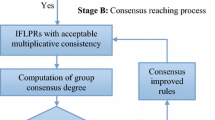Abstract
The aim of this paper is to propose a new type of preference relation, the intuitionistic fuzzy linguistic preference relation (IFLPR). Taking as base the 2-tuple fuzzy linguistic representation model, we introduce the definition of the IFLPR, and its transitivity properties. We present an approach to group decision making based on IFLPRs and incomplete-IFLPRs, respectively. The score function and accuracy function are applied to the ranking and selection of alternatives. Finally, we give an example of IFLPRs in group decision making, and a comparative of the exploitation of the IFLPR with the exploitation of the traditional fuzzy linguistic preference relations.
Similar content being viewed by others
References
Alonso S, Chiclana F, Herrera F, Herrera-Viedma E (2004) A learning procedure to estimate missing values in fuzzy preference relations based on additive consistency. MDAI2004, LNAI, vol 3131, pp 227–238
Alonso S, Chiclana F, Herrera F, Herrera-Viedma E (2008) A consistency-based procedure to estimate missing pairwise preference values. Int J Intell Syst 23:155–175
Alonso S, Cabrerizo FJ, Chiclana F, Herrera F, Herrera-Viedma E (2009) Group decision making with incomplete fuzzy linguistic preference relations. Int J Intell Syst 24(2):201–222
Atanssov K (1986) Intuitionistic fuzzy sets. Fuzzy Sets Syst 20:87–96
Bonissone PP, Decker KS (1986) Selecting uncertainty calculi and granularity: an experiment in trading-off precision and complexity. In: Kanal LH, Lemmer JF (eds) Uncertainty in artificial intelligence. North-Holland, Amsterdam, pp 217–247
Cabrerizo FJ, Heradio R, Perez IJ, Herrera-Viedma E (2010) A selection process based on additive consistency to deal with incomplete fuzzy linguistic information. J Univers Comput Sci 16(1):62–81
Carlsson C, Fuller R (2000) Benchmarking and linguistic importance weighted aggregations. Fuzzy Sets Syst 114:35–42
Chen SM, Tan JM (1994) Handling multicriteria fuzzy decision-making problems based on vague set theory. Fuzzy Sets Syst 67(2):163–172
Chiclana F, Herrera-Viedma E, Alonso S (2009) A note on two methods for estimating missing pairwise preference values. IEEE Trans Syst Man Cybern B Cybern 39(6):1628–1633
Delgado M, Verdegay JL, Vila MA (1993) On aggregation operations of linguistic labels. Int J Intell Syst 8(3):351–370
Deschrijver G, Kerre EE (2003) On the composition of intuitionistic fuzzy relations. Fuzzy Sets Syst 136(3):333–361
Espinilla M, Liu J, Martínez L (2011) An extended hierarchical linguistic model for decision-making problems. Comput Intell 27:489–512
Fedrizzi M, Giove S (2007) Incomplete pairwise comparison and consistency optimization. Eur J Oper Res 183:303–313
Herrera F, Herrera-Viedma E (2000) Linguistic decision analysis: steps for solving decision problems under linguistic information. Fuzzy Sets Syst 115(1):67–82
Herrera F, Martínez L (2000) A 2-tuple fuzzy linguistic representation model for computing with words. IEEE Trans Fuzzy Syst 8(6):746–752
Herrera F, Martínez L (2001) The 2-tuple linguistic computational model. Advantages of its linguistic description, accuracy and consistency. Int J Uncertain Fuzziness Knowl Based Syst 9:33–48
Herrera F, Herrera-Viedma E, Verdegay JL (1995) A sequential selection process in group decision making with a linguistic assessment approach. Inform Sci 85:223–239
Herrera F, Herrera-Viedma E, Verdegay JL (1996) Direct approach processes in group decision making using linguistic OWA operators. Fuzzy Sets Syst 79(2):175–190
Herrera F, Martínez L, Sanchez PJ (2005) Managing non-homogeneous information in group decision making. Eur J Oper Res 166:115–132
Herrera-Viedma E, Chiclana F, Herrera F, Alonso S (2007) Group decision-making model with incomplete fuzzy preference relations based on additive consistency. IEEE Trans Syst Man Cybern B Cybern 37(1):176–189
Hong DH, Choi CH (2000) Multicriteria fuzzy decision-making problems based on vague set theory. Fuzzy Sets Syst 114(1):103–113
Kim SH, Ahn BS (1997) Group decision making procedure considering preference strength under incomplete information. Comput Oper Res 24(12):1101–1112
Ngwenyama O, Bryson N (1999) Eliciting and mapping qualitative preferences to numeric rankings in group decision making. Eur J Oper Res 116(3):487–497
Rodríguez RM, Martínez L, Herrera F (2012) Hesitant fuzzy linguistic terms sets for decision making. IEEE Trans Fuzzy Syst 20(1):109–119
Szmidt E, Kacprzyk J (1998) Group decision making under intuitionistic fuzzy preference relations. In: Proceedings of 7th IPMU conference, Paris, pp 172–178
Szmidt E, Kacprzyk J (2002) Using intuitionistic fuzzy sets in group decision making. Control Cybern 31(4):1037–1053
Wang JH, Hao J (2006) A new version of 2-tuple fuzzy linguistic representation model for computing with words. IEEE Trans Fuzzy Syst 14(3):435–445
Xu ZS (2007) Intuitionistic preference relations and their application in group decision making. Inform Sci 177:2363–2379
Xu ZS, Yager RR (2009) Intuitionistic and interval-valued intuitionistic fuzzy preference relations and their measures of similarity for the evaluation of agreement within a group. Fuzzy Optim Decis Making 8(2):123–139
Zadeh LA (1975) The concept of a linguistic variable and its application to approximate reasoning. Inform Sci 8(3):199–249
Zhang GQ, Dong YC, Xu YF (2012) Linear optimization modeling of consistency issues in group decision making based on fuzzy preference relations. Expert Syst Appl 39(3):2415–2420
Author information
Authors and Affiliations
Corresponding author
Rights and permissions
About this article
Cite this article
Zhang, Y., Ma, H., Liu, B. et al. Group decision making with 2-tuple intuitionistic fuzzy linguistic preference relations. Soft Comput 16, 1439–1446 (2012). https://doi.org/10.1007/s00500-012-0847-z
Published:
Issue Date:
DOI: https://doi.org/10.1007/s00500-012-0847-z




